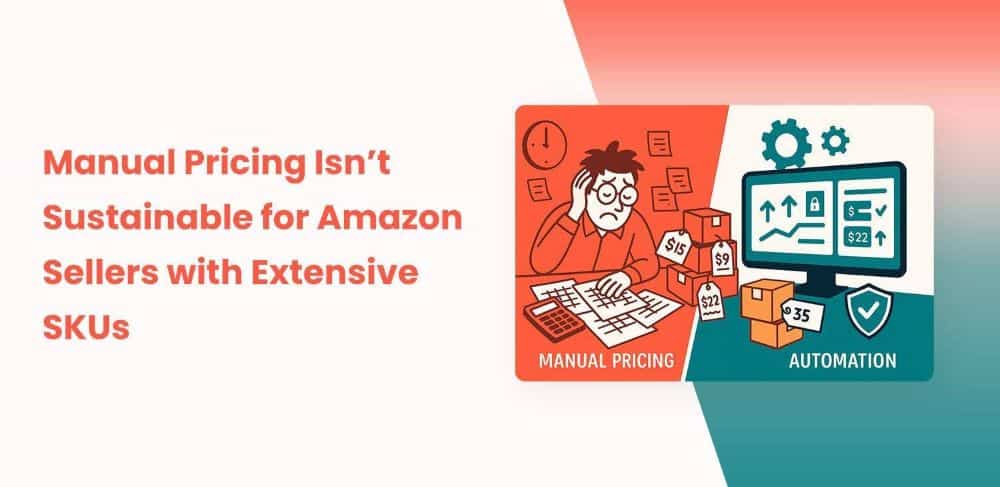Selling on Amazon is competitive, and once your catalog grows past a hundred SKUs, the challenges multiply quickly. What may have worked when you had a handful of listings becomes overwhelming as your inventory expands. Pricing every product manually is not only exhausting but also risky because the market shifts too quickly. Competitors change prices throughout the day, demand rises and falls, and seasonal events can flip the market overnight. Relying on manual updates puts sellers at a disadvantage and makes it almost impossible to keep up.
This post by Alpha Repricer takes a closer look at why manual pricing no longer works when you manage 100 or more SKUs, and how automation can completely change the game for growing businesses.
The Pressure of Managing Large Catalogs
Sellers with over 100 SKUs are juggling dozens of competitors across multiple categories. Each SKU comes with its own pricing battles, customer demand patterns, and margin considerations. Trying to adjust all of this manually creates serious challenges. Prices can go out of date in a matter of minutes, competitors can undercut you while you are asleep, and margins may collapse if you miscalculate. On top of this, hours spent updating spreadsheets could instead be used for sourcing profitable products or improving customer service. At scale, manual pricing drains both time and profit.
Why Automation Becomes Non-Negotiable
Automated repricing takes over the heavy lifting. Instead of chasing competitor updates by hand, sellers can rely on a system that monitors prices around the clock and adjusts within seconds. This means you remain competitive whether it’s midday or midnight. Even better, you can set boundaries to protect your margins so you never sell below a profitable point. Automation ensures that every product gets the attention it needs, freeing you to focus on growth instead of repetitive updates.
The Right Repricer for Growing Sellers
When a catalog hits 100 SKUs or more, the need for a reliable tool becomes clear. A repricer for Amazon sellers with 100+ SKUs helps manage complexity by applying strategies across different types of products. For example, you might set one approach for wholesale items, another for private label products, and a third for B2B listings. This kind of flexibility is impossible to maintain manually. With the right system in place, your pricing adapts instantly to changes in the marketplace, giving you the best chance to win the Featured Offer and maximize profits.
Mistakes Sellers Make with Manual Pricing
Here are some of the most common pitfalls sellers face when they rely on manual pricing:
- Lowering prices too aggressively, cutting profits more than necessary
- Updating too slowly and losing visibility to faster competitors
- Failing to adjust for stock velocity, which can cause stockouts
- Missing opportunities during seasonal peaks when demand changes rapidly
Each of these mistakes becomes more damaging as the catalog grows. Automation solves these challenges by adjusting prices consistently and strategically.
Pricing and Inventory Go Hand in Hand
Pricing is not separate from inventory management. The way you price affects how quickly products sell, which in turn affects how much stock you need on hand. For example, during the holiday rush, competitive pricing can drive sales volumes higher than expected. Without proper planning, you could run out of stock just when demand peaks. By using a smart repricer, it becomes much easier to prepare inventory for holiday demand because you can balance price adjustments with available stock. This ensures you don’t oversell while still capturing as much profit as possible.
Long-Term Gains of Smart Repricing
Automated repricing delivers more than just short-term competitiveness. Its long-term benefits include:
- Sustainable growth by freeing up time for scaling
- Data-driven improvements with detailed performance tracking
- Stronger customer trust through consistent and fair pricing
- Steady profitability by protecting margins across your catalog
These benefits ensure sellers are not just chasing sales but also building a healthier, more profitable business.
Conclusion
Managing over 100 SKUs on Amazon comes with its own set of challenges, and manual pricing is no longer realistic. The market moves too fast for spreadsheets and occasional updates. Sellers who continue to rely on manual methods risk losing visibility, profits, and valuable time. Automation, on the other hand, offers round-the-clock adjustments, margin protection, and the scalability needed for serious growth.
According to our experience, once your catalog crosses 100 SKUs, switching to automated repricing is not just an option, it is a necessity. It is the step that allows sellers to compete confidently, prepare for demand surges, and build a profitable business on Amazon.

